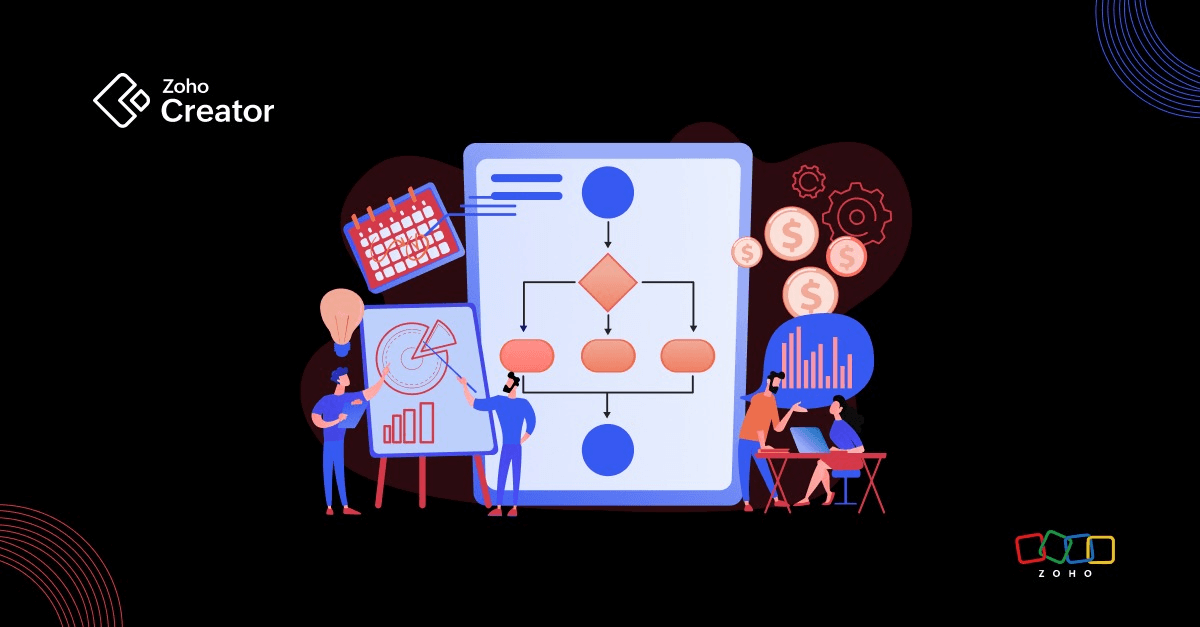- HOME
- Know Your Tech
- How to replace spreadsheet chaos with real workflows in 30 days
How to replace spreadsheet chaos with real workflows in 30 days
- Last Updated : October 30, 2025
- 87 Views
- 7 Min Read
Spreadsheets are powerful tools—and for many tasks, they're the perfect solution. But as a business grows, the very spreadsheets that once helped you organize can become a source of chaos. Multiple versions of the same file get passed around in emails, critical data gets locked in cells, and one person’s complex macros become an operational risk. If this sounds familiar, you're not alone.
This isn't about ditching spreadsheets entirely; it's about using the right tool for the job. In this article, we provides a practical, 30-day guide to help you identify spreadsheet chaos, build a case for change, and migrate to structured workflows that save time, reduce risk, and help your business scale.
So what is "spreadsheet chaos"?
Spreadsheet chaos is the point when a spreadsheet system becomes too complex, fragile, and manual to support a business process effectively. It often hides in plain sight within key operations.
Think about your finance, inventory, HR, or project management tasks. Are they run on spreadsheets with countless tabs, hidden formulas, and confusing version names like Report_v2_final_FINAL.xlsx?
That's spreadsheet chaos.
Here are a few signs you’ve outgrown your spreadsheets:
More than five people need to edit the same sheet regularly.
You're storing sensitive customer or employee data (PII/PHI) in unsecured tabs.
Your monthly process involves manually copying and pasting large chunks of data.
Email is your primary tool for tracking changes and getting approvals on spreadsheet data.
Crucial formulas are understood by only one or two people in the entire company.
The real cost of spreadsheet chaos
The problems with spreadsheet chaos go beyond simple frustration—they carry real costs that can impact your bottom line and expose your business to risk.
Direct costs: Manual data entry and copy-paste tasks lead to errors, which require hours of rework. Slow, manual reporting means decisions are based on outdated information.
Indirect costs: Without proper audit trails and permissions, you face significant compliance risks. When the one person who understands the "macro magic" leaves, the entire process can grind to a halt.
Opportunity costs: Every hour your team spends stitching data together or fixing broken formulas is an hour they aren't spending on improving processes or serving customers.
When to keep spreadsheets and when to move on
Spreadsheets still have their place; they're excellent for individual analysis, creating quick prototypes for data models, or running one-off calculations, and they provide a flexible canvas for exploration.
However, it's time to graduate to a dedicated application when your process involves:
Collaboration: Multiple teams or users need to update data simultaneously.
Access control: You need role-based permissions to control who can view or edit specific information.
Automation: The process requires approvals, notifications, or integrations with other systems, like your CRM or ERP.
Compliance: You need to maintain a clear, unchangeable audit trail for regulatory purposes.
Build the business case for change
Moving away from a familiar tool requires a clear justification. You can build a compelling business case by focusing on two key areas: ROI and risk reduction.
Calculate the ROI: Estimate the number of hours your team spends on manual spreadsheet work each week. Multiply that by a blended hourly rate to find the cost of inefficiency. Add the potential savings from reducing errors. Compare this to the cost of a workflow application to show a clear return on investment.
Highlight risk reduction: Frame the change in terms of security and compliance. A dedicated application provides audit trails, granular permissions, automated backups, and clear data retention policies—features that are nearly impossible to enforce in a spreadsheet environment.
Prioritize what to fix first
You can't fix everything at once. Use a simple scoring matrix to identify which spreadsheets are causing the most pain and posing the biggest risks.
Rank your key spreadsheets by scoring them on factors like:
Number of users/editors
Frequency of updates
Involvement of sensitive data
Need for integrations with other software
Importance for audits or compliance
The sheets with the highest scores are your top candidates for phase one of your migration project.
Why a low-code platform is ideal for replacing spreadsheets
Switching from spreadsheets to a low-code platform offers a practical path for businesses ready to streamline operations without over-complicating things. Low-code solutions let you build custom workflows and applications with drag-and-drop tools—no programming expertise required. This drastically lowers the barrier to digital transformation, empowering both IT teams and business users to collaborate on process improvements.
With a low-code platform, you get:
Ease of use: Anyone familiar with spreadsheets can quickly pick up low-code tools and start building without steep technical learning curves.
Faster implementation: You can turn ideas into working applications in days or weeks, not months, keeping your business agile and responsive.
Built-in flexibility: Low-code apps adapt as your processes evolve, making it simple to add fields, forms, or approval steps as needs change.
Stronger controls: Configure role-based access, validations, and audit trails out of the box—features that are tricky to maintain in spreadsheets.
Low-code platforms bridge the gap between spreadsheet convenience and the control, automation, and security your business needs. That makes them an ideal next step before diving in to full-scale custom development.
A 30-day migration playbook
Once you've identified your priorities, you can follow this step-by-step playbook to move from a spreadsheet to a structured application in about a month.
Week 1: Discover and design
Discover: Take inventory of your target spreadsheet. Identify the owner, data sources, and all manual steps involved. Map out how data flows into, through, and out of the sheet.
Design: Rethink the process as a structured workflow. Define the data tables, fields, and relationships you'll need. Sketch out the forms for data entry, the steps for approvals, and the notifications required at each stage.
Week 2: Build the application
Create the foundation: In your chosen low-code or workflow platform, build the data tables and fields. Set up validation rules (e.g., this field must be a number, this one can't be blank).
Configure workflows: Build the forms for users to submit and edit data. Configure the approval workflows and set up role-based access to ensure users only see what they need to see.
Build dashboards: Create real-time dashboards to track key metrics, statuses, and exceptions.
Week 3: Migrate and test
Clean and import: Clean the legacy data in the spreadsheet. Fix inconsistencies, remove duplicates, and ensure data types are correct. Import the cleaned data into your new application.
Test with users: Involve a few key users to test the new system with real data. This user acceptance testing (UAT) helps catch issues before a full launch.
Freeze the spreadsheet: Once testing is complete, make the old spreadsheet read-only. Communicate clearly to all users that updates must now happen in the new application.
Week 4: Train and govern
Train your team: Provide role-specific training. A simple "what's changed" guide can help users adapt quickly. Offer office hours or a sandbox environment for practice.
Establish governance: Define ownership, a process for requesting changes, and a schedule for backups and access reviews. The goal is to ensure the new system remains clean, secure, and effective over time.
Metrics that show you've eliminated the chaos
How do you know the migration was a success? Track these indicators:
Adoption: Are people using the new system? Look at weekly active users and the number of tasks completed.
Efficiency: Has the process become faster? Measure the cycle time from a request's creation to its approval.
Data quality: Are errors decreasing? Track the percentage of records that fail validation.
Risk reduction: Can you prove compliance? The number of audit exceptions should fall, and you'll no longer have sensitive data floating in unsecured spreadsheets.
Conclusion
Breaking free from spreadsheet chaos is about more than just adopting new software. It’s about redesigning your processes for scalability, security, and efficiency.
By starting small, proving the value, and following a structured plan, you can replace frustrating manual work with streamlined workflows in just 30 days.
You'll not only save time and money but also empower your team to focus on work that truly matters.
Frequently asked questions (FAQ)
1. What’s the difference between a dashboard and a spreadsheet report?
A spreadsheet report is a static snapshot of data at a specific moment. A dashboard in a workflow application is dynamic and updates in real time as new data comes in, providing a live view of your operations.
2. Can we keep spreadsheets for analysis but move operations to an app?
Absolutely. This is often the ideal setup. Use a dedicated application to manage the day-to-day operational process, then export clean, structured data from the app into a spreadsheet for deeper, one-off analysis.
3. How do we enforce permissions and audit trails?
Modern workflow applications have this built in. You can configure role-based permissions to control who can view, create, or edit data. The system automatically logs every change—who made it, what they changed, and when—creating a complete, uneditable audit trail for compliance.
4. What’s the best way to handle CSV imports and deduplication?
Before importing a CSV, clean the data in a spreadsheet program to fix typos and ensure consistent formatting. Most workflow platforms have built-in tools that can help you map columns from your CSV to the fields in your new application and identify duplicates based on a unique ID (like an email address or order number).
5. How do we manage versions and change requests after go-live?
Establish a formal change control process. Users should submit change requests through a defined channel. For the application itself, use a sandbox or development environment to test changes before deploying them to the live version. This prevents accidental disruptions to your live operations.
 Pranesh
PraneshPranesh is a serial entrepreneur and the Founder of Studio 31, a 12 year old, deep tech enabled, wedding photography and film company that has been recognized by many publications for its zero inventory model and unique culture in the unorganised sector.
Zoho Creator has helped Studio 31 redefine its business model by automating over 37 processes and save three hours every single day. He is also a growth consultant for Zoho Creator and helps the team address real-world challenges from a customer's point of view.



